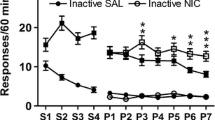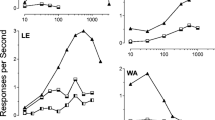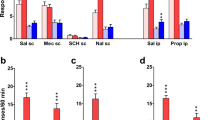Abstract
Behavioural effects of d- and l-nicotine, d- and l-nornicotine and l-cotinine were studied in two paradigms. In experiment 1, rats responded under a multiple fixed-interval (FI) 5 min, fixed-ratio (FR) 20 schedule of food presentation. Aside from differences in potency and time course, l-nicotine and the stereoisomers of nornicotine produced qualitatively similar effects on rates of responding. With increasing doses of drugs, FI response rates first increased and then decreased, while FR response rates only decreased. In contrast, d-nicotine did not significantly increase FI response rates at lower doses, and only decreased FI and FR response rates at higher doses. At doses up to 100 mg/kg, cotinine produced only dose-dependent increases in FI response rates and had no effect on FR response rates. Rate-increasing effects of cotinine were not blocked by mecamylamine. In experiment 2, rats were trained to discriminate between l-nicotine (0.1 mg/kg SC) and saline (0.1 mg/kg SC) in a two-bar, operant conditioning procedure under a tandem variable-interval (VI) 1 min, FR 10 schedule of food presentation. Full generalization was obtained to d-nicotine and to l- and d-nornicotine. Generalization to cotinine occurred only with large doses that contained significant amounts of nicotine present as an impurity. There was no generalization to non-nicotinic drugs (morphine and clenbuterol), even at doses that reduced response rates. The rank order of potency for nicotine and its analogues was similar in experiments 1 and 2: l-nicotine was 10–20 times more potent than d-nicotine and the stereoisomers of nornicotine (which did not show stereoselectivity in the rat). Cotinine was at least several hundred times less potent than nicotine. Behavioural potencies correlated with previously reported concentrations of the analogues needed to reduce binding of tritiated nicotine to rat brain membranes
Similar content being viewed by others
References
Benowitz NL, Kuyt F, Jacob P, Jones RT, Osman A-L (1983) Cotinine disposition and effects. Clin Pharmacol Ther 34:604–611.
Clark MSG, Rand MJ, Vanov S (1965) Comparison of pharmacological activity of nicotine and related alkaloids occurring in cigarette smoke. Arch Int Pharmacodyn 156:363–379.
Davis TRA, Kensler CJ, Dews PB (1973) Comparison of behavioral effects of nicotine, d-amphetamine, caffeine and dimethylheptyl tetrahydrocannabinol in squirrel monkeys. Psychopharmacologia 32:51–65.
DeNoble VJ, Dragan YP, Carron L (1982) Behavioural effects of intraventricularly administered (-)-nicotine on fixed ratio schedules of food presentation in rats. Psychopharmacology 77:317–321.
Feyerabend C, Russell MAH (1980) Assay of nicotine in biological materials: sources of contamination and their elimination. J Pharm Pharmacol 32:178–181.
Garcha HS, Goldberg SR, Reavill C, Risner ME, Stolerman IP (1986) Behavioural effects of the optical isomers of nicotine and nornicotine, and of cotinine, in rats. Br J Pharmacol 88:298P
Goldberg SR, Spealman RD, Risner ME, Henningfield JE (1983) Control of behavior by intravenous nicotine injections in laboratory animals. Pharmacol Biochem Behav 19:1011–1020.
Hicks CS, Mackay ME, Sinclair DA (1947) The comparative pharmacology of the nor-nicotines. Aust J Exp Biol Med Sci 25:363–372.
Martin BR (1987) Stereoselectivity of nicotine's central effects and its relationship to pain and cardiovascular function. In: Martin WR, Van Loon GR, Iwamoto ET, Davis L (eds) Tobacco smoking and nicotine. Plenum Press New York, pp 301–316.
Meltzer LT, Rosecrans JA, Aceto MD, Harris LS (1980) Discriminative stimulus properties of the optical isomers of nicotine. Psychopharmacology 68:283–286.
Morrison CF (1967) Effects of nicotine on operant behaviour of rats. Int J Neuropharmacol 6:229–240.
Pradhan SN (1970) Effects of nicotine on several schedules of behavior in rats. Arch int Pharmacodyn 183:127–138.
Pratt JA, Stolerman IP, Garcha HS, Giardini V, Feyerabend C (1983) Discriminative stimulus properties of nicotine: further evidence for mediation at a cholinergic receptor. Psychopharmacology 81:54–50.
Reavill C, Spivak CE, Stolerman IP, Waters JA (1987) Isoarecolone can inhibit nicotine binding and produce nicotine-like discriminative stimulus effects in rats. Neuropharmacology 26:789–792.
Reavill C, Jenner P, Kumar R, Stolerman IP (1988) High-affinity binding of [3H](-)-nicotine to rat brain membranes and its inhibition by analogues of nicotine. Neuropharmacology 27:235–241.
Risner ME, Goldberg SR, Prada JA, Cone EJ (1985) Effects of nicotine, cocaine and some of their metabolites on schedule-controlled responding by beagle dogs and squirrel monkeys. J Pharmacol Exp Ther 234:113–119.
Risner ME, Cone EJ, Benowitz NL, Jacob III P (1988) Effects of the stereoisomers of nicotine and nornicotine on schedule-controlled responding and physiological parameters of dogs. J Pharmacol Exp Ther 244:807–813.
Romano C, Goldstein A, Jewell NP (1981) Characterization of the receptor mediating the nicotine discriminative stimulus. Psychopharmacology 74:310–315.
Rosecrans JA, Spencer RM, Krynock GM, Chance WT (1978) Discriminative stimulus properties of nicotine and nicotine-related compounds. In: Bättig K (ed) Behavioral effects of nicotine. Karger, Basel, pp 70–82.
Spealman RD, Goldberg SR, Gardner ML (1981) Behavioral effects of nicotine: schedule-controlled responding by squirrel monkeys. J Pharmacol Exp Ther 216:484–491.
Stolerman IP, Garcha HS, Pratt JA, Kumar R (1984) Role of training dose in discrimination of nicotine and related compounds by rats. Psychopharmacology 84:413–419.
White JM, Ganguzza CC (1985) Effects of nicotine on schedule-controlled behavior. Role of fixed-interval length and modification by mecamylamine and chlorpromazine. Neuropharmacology 24:75–82.
Winer BJ (1971) Statistical principles in experimental design, 2nd edn. McGraw-Hill, New York
Author information
Authors and Affiliations
Rights and permissions
About this article
Cite this article
Goldberg, S.R., Risner, M.E., Stolerman, I.P. et al. Nicotine and some related compounds: effects on schedule-controlled behaviour and discriminative properties in rats. Psychopharmacology 97, 295–302 (1989). https://doi.org/10.1007/BF00439441
Received:
Accepted:
Issue Date:
DOI: https://doi.org/10.1007/BF00439441




